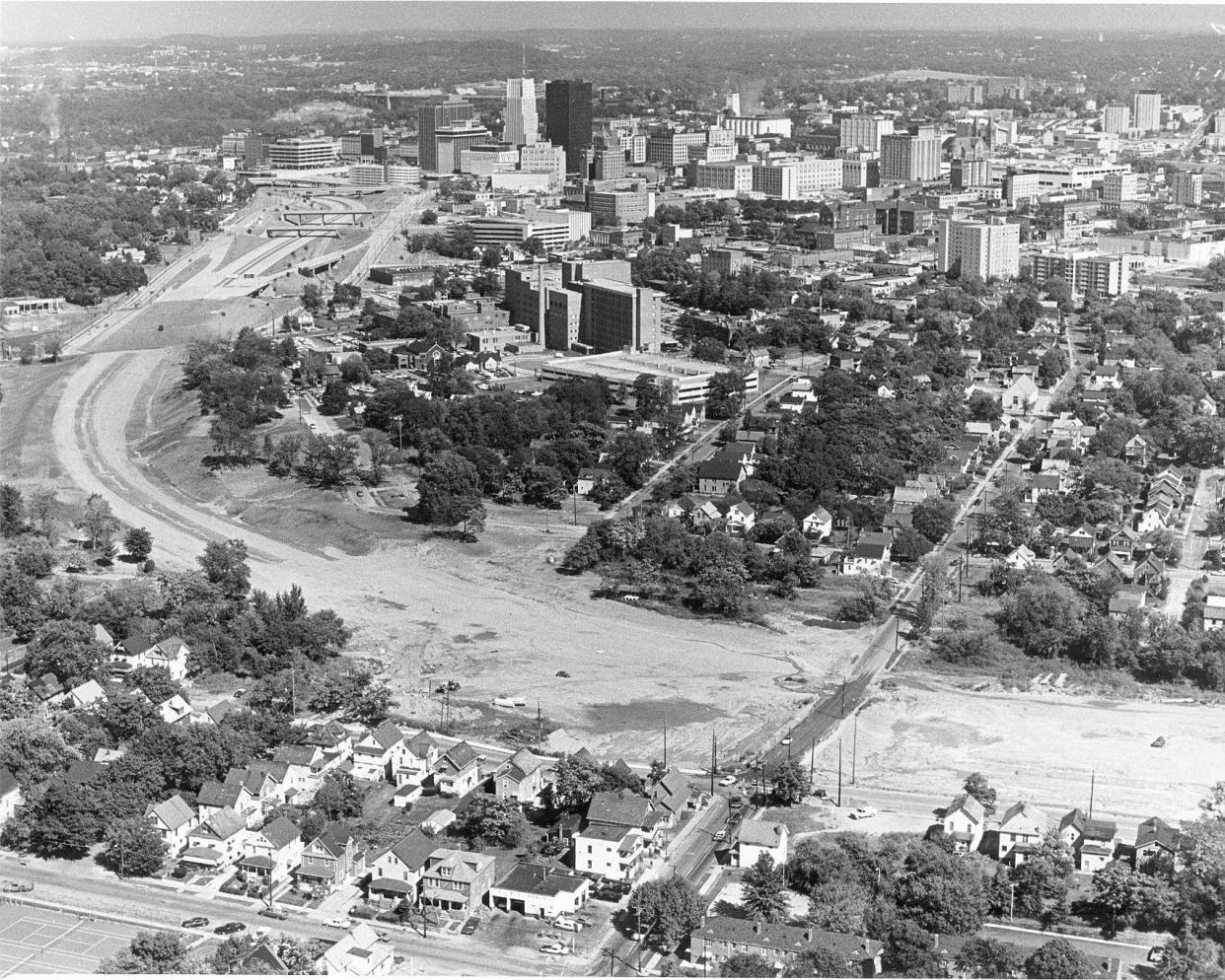Akron gets $960K U.S. Department of Transportation grant for plan on future of Innerbelt

The city of Akron is receiving a $960,000 grant from the U.S. Department of Transportation to create a community-based master plan on future uses for the decommissioned mile-long portion of the Akron Innerbelt.
The grant is part of the new federal Reconnecting Communities Pilot Program, which is meant to reconnect communities that are cut off from opportunity and burdened by past transportation infrastructure decisions.
Construction on the Innerbelt (state Route 59) began in 1970, displacing residents and businesses and especially affecting Black residents. A portion of the Innerbelt between Market and Exchange streets was permanently closed in 2017.
According to the city, the Innerbelt, sometimes referred to as Akron’s “Road to Nowhere,” was never fully completed, never saw the traffic counts predicted for it, and, like many urban renewal projects from the 1970s, its promises of revitalization never materialized for Akron and its residents.
Akron Innerbelt:The failed Akron Innerbelt drove decades of racial inequity. Can the damage be repaired?
The city in June announced a public engagement process, "Reconnecting Our Community," to come up with plans for the future of the site in downtown Akron.
“The work that our Innerbelt Advisory group has done over the past two years is really laying the foundation for the Innerbelt’s future," Akron Mayor Dan Horrigan said in a statement. "We’ve been working hand in hand with the community, engaging them on what they envision as the best use for this land, and we’re excited to use this funding to look at short- and long-term strategies to address the challenges posed by the Innerbelt.”
The Beacon Journal published an extensive enterprise report on the history of the Innerbelt in February 2022 and co-sponsored an August 2022 event attended by many people who shared their stories.
There's also an Innerbelt History Collection project with audio recordings, video recordings, photographs and maps at Summit Memory, summitmemory.org/digital/custom/innerbelt.
Akron Innerbelt grant part of federal Reconnecting Communities Pilot Program
The city said that as part of the work, it hopes to get a more detailed look at how the existing infrastructure (including streets, ramps and bridges), topography and land use could be altered and utilized to create a usable space.
“The master plan will look at ways to improve the mobility and community connectivity in the area, including reconnecting the street grid, promoting multi-modal transportation, providing infill housing on the site, removing roadways, and calming traffic on frontage roads,” the Department of Transportation said in a statement. “It will also consider including trails, green space, and public art. The project intends to create a master plan rooted in community visioning to promote equitable development, possibly including infill development on the vacated highway, including affordable housing and local business development with attention to the area’s history.”
The Reconnecting Communities Pilot Program, which was established by President Joe Biden's Bipartisan Infrastructure Law, “provides technical assistance and funding for communities’ planning and construction projects that aim to connect neighborhoods back together by removing, retrofitting, or mitigating transportation barriers such as highways and railroad tracks,” the department said.
“Transportation infrastructure should help people get where they need to be, but, too often in our nation’s history, transportation infrastructure has done the opposite by dividing neighborhoods and cutting off communities from opportunity,” the department said. “For example, highways and rail lines can be physical barriers, preventing residents from easy access to social and economic opportunities. This burden is often felt most by communities of color."
Akron Innerbelt:‘It was ... devastating’: The Akron Innerbelt destroyed Black-owned businesses in its path
Akron is one of 45 projects receiving $185 million in grant awards in the first round of funding for the program. The Bipartisan Infrastructure Law will invest $1 billion over five years to address infrastructure barriers that limit mobility, access or economic development for communities across the country, according to the Department of Transportation.
The department said that it “prioritized applications from economically disadvantaged communities, especially those focused on equity and environmental justice, and that demonstrated strong community engagement and stewardship, and would catalyze shared prosperity in its development and job creation.”
“Transportation should connect, not divide, people and communities,” U.S. Transportation Secretary Pete Buttigieg said in a statement. “We are proud to announce the first grantees of our Reconnecting Communities Program, which will unite neighborhoods, ensure the future is better than the past, and provide Americans with better access to jobs, health care, groceries and other essentials.”
For more information, visit akroninnerbelt.com or transportation.gov/grants/reconnecting-communities.
Contact Beacon Journal reporter Emily Mills at emills@thebeaconjournal.com and on Twitter @EmilyMills818.
This article originally appeared on Akron Beacon Journal: Akron gets Department of Transportation grant for Innerbelt plan

